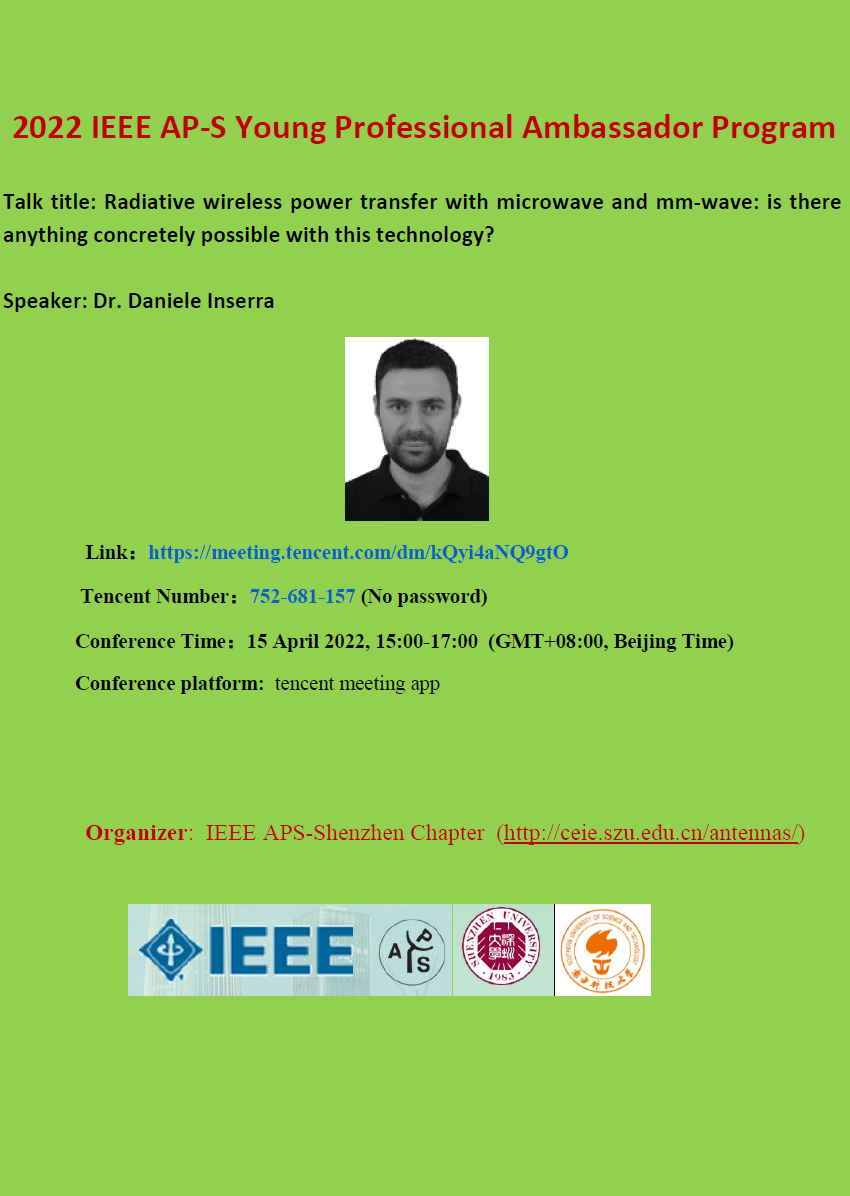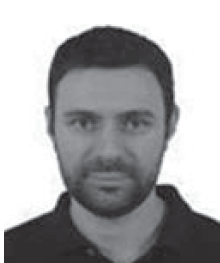Radiative wireless power transfer with microwave and mm-wave: is there anything concretely possible with this technology?
2022 IEEE AP-S Young Professional Ambassador Program

Energy sustainability is a major concern in 6G and Internet-of-Things (IoT) due to the lack of mature solutions for powering and keeping uninterrupted operations for a massive number of devices. Therefore, wireless power transfer (WPT) and energy harvesting (EH) technologies are now strongly under investigation by the research community and industries. Ambient EH does not require additional resource/power consumption from the surrounded energy network infrastructure, but it usually requires longer time to harvest sufficient energy. Moreover, temporal/geographical/environmental circumstances may limit ambient EH services making them inappropriate for many use cases with quality of service (QoS) requirements. For what the dedicated WPT concerns, it can be subdivided into either near-field (NF) or far-field (FF) WPT, according to the electromagnetic coupling phenomenon which makes possible the wireless transfer of energy: NF WPT is mainly based on induction (based on the inductive coupling effect of non-radiative electromagnetic fields, including the inductive and capacitive mechanisms, and is subject to coupling misalignment impairments that limit the range and scalability) or magnetic coupling between objects (coils) resonating at the same frequency which tend to couple with each other efficiently, and these phenomena happen within the reactive region (non-radiative) of the generated fields; on the other hand, FF WPT, also known as radiative WPT, exploits the propagation of the electromagnetic field in the radiative region of an antenna device, similarly to a wireless communication system. Because of the different coupling phenomenon, NF WPT is usually associated to short-range WPT where it can achieve high efficiency, while radiative WPT is often the choice for long-range WPT. Therefore, radiative WPT constitutes the most prominent technology for massively and wirelessly powering low-energy IoT deployments, which can be combined with ambient EH for low duty-cycle communication requirements. Unfortunately, radiative WPT is not as effective as NF WPT because of the limited sensitivity of conventionally employed Schottky rectification diodes, and this is strongly limiting the application of this technology in practice, except for few cases. Nonetheless, the discussion about the radiative WPT applicability has been left at a relatively general level in the open literature, which mainly discusses WPT system components and their design/implementation separately, without instead analyze the complete WPT system efficiency maximization problem.
In this lecture, the fundamental concepts of WPT will be introduced by analyzing all components of a conventional WPT system. After that, the talk will focus on the air link radiative WPT section and will discuss the theoretical power transfer efficiency of two antenna apertures and its dependency on the working frequency, for both narrowband and wideband transmitting signals. The design and optimization of high efficiency discrete apertures will be then described based on microwave network theory. This analysis framework will also be extended to the complete radiative WPT system design, highlighting that the non-linearity of power source and rectification components requires to consider the whole radiative WPT system optimization and not only the single component efficiency maximization. Finally the applicability of the radiative WPT technology will be discussed, with particular emphasis on microwave space-based solar power stations and millimeter-wave frequencies regime.
Date and Time
Location
Hosts
Registration
-
 Add Event to Calendar
Add Event to Calendar
Loading virtual attendance info...
- Contact Event Host
- Co-sponsored by IEEE APS-Shenzhen Chapter
- Survey: Fill out the survey
Speakers
 Daniele Inserra
Daniele Inserra
Radiative wireless power transfer with microwave and mm-wave: is there anything concretely possible with this technology
Abstract: Energy sustainability is a major concern in 6G and Internet-of-Things (IoT) due to the lack of mature solutions for powering and keeping uninterrupted operations for a massive number of devices. Therefore, wireless power transfer (WPT) and energy harvesting (EH) technologies are now strongly under investigation by the research community and industries. Ambient EH does not require additional resource/power consumption from the surrounded energy network infrastructure, but it usually requires longer time to harvest sufficient energy. Moreover, temporal/geographical/environmental circumstances may limit ambient EH services making them inappropriate for many use cases with quality of service (QoS) requirements. For what the dedicated WPT concerns, it can be subdivided into either near-field (NF) or far-field (FF) WPT, according to the electromagnetic coupling phenomenon which makes possible the wireless transfer of energy: NF WPT is mainly based on induction (based on the inductive coupling effect of non-radiative electromagnetic fields, including the inductive and capacitive mechanisms, and is subject to coupling misalignment impairments that limit the range and scalability) or magnetic coupling between objects (coils) resonating at the same frequency which tend to couple with each other efficiently, and these phenomena happen within the reactive region (non-radiative) of the generated fields; on the other hand, FF WPT, also known as radiative WPT, exploits the propagation of the electromagnetic field in the radiative region of an antenna device, similarly to a wireless communication system. Because of the different coupling phenomenon, NF WPT is usually associated to short-range WPT where it can achieve high efficiency, while radiative WPT is often the choice for long-range WPT. Therefore, radiative WPT constitutes the most prominent technology for massively and wirelessly powering low-energy IoT deployments, which can be combined with ambient EH for low duty-cycle communication requirements. Unfortunately, radiative WPT is not as effective as NF WPT because of the limited sensitivity of conventionally employed Schottky rectification diodes, and this is strongly limiting the application of this technology in practice, except for few cases. Nonetheless, the discussion about the radiative WPT applicability has been left at a relatively general level in the open literature, which mainly discusses WPT system components and their design/implementation separately, without instead analyze the complete WPT system efficiency maximization problem.
In this lecture, the fundamental concepts of WPT will be introduced by analyzing all components of a conventional WPT system. After that, the talk will focus on the air link radiative WPT section and will discuss the theoretical power transfer efficiency of two antenna apertures and its dependency on the working frequency, for both narrowband and wideband transmitting signals. The design and optimization of high efficiency discrete apertures will be then described based on microwave network theory. This analysis framework will also be extended to the complete radiative WPT system design, highlighting that the non-linearity of power source and rectification components requires to consider the whole radiative WPT system optimization and not only the single component efficiency maximization. Finally the applicability of the radiative WPT technology will be discussed, with particular emphasis on microwave space-based solar power stations and millimeter-wave frequencies regime.
Biography:
BIO: Daniele Inserra (S’10 - M’16) received the BSc Degree (2007) and the MSc Degree (2009, summa cum laude) in electrical engineering, and the Ph.D. degree in industrial and information engineering (2013), all from the University of Udine, Udine, Italy. He was a member of the Wireless and Power Line Communications Lab at the University of Udine until 2013. From 2013 to 2014 he was with Calzavara S.p.a., Italy, as both responsible of the Non Ionizing Radiation Laboratory measurement activities and a member of the technical staff (antennas and electromagnetic compatibility designer). From 2015 to 2021 he was a postdoctoral research fellow with the University of Electronic Science and Technology of China, Chengdu, China, where now he is an associate professor. His research interests include antenna and antenna array design, RFID systems, wireless power transfer and energy harvesting, infomobility, wireless and power line communication systems, radio localization and positioning techniques, hardware/software co-design, rapid prototyping methodologies, hardware and RF devices characterization and measurement systems.
He received the Young Scientist Award at Photonics and Electromagnetism Research Symposium (PIERS), 21-25 November 2021, Hangzhou, China, and he was selected as IEEE Antennas and Propagation Society Young Professional Ambassador for the year 2022. He has authored more than 60 journal and/or conference papers, one book chapter, and he holds 4 patents. He serves as reviewer of many IEEE journals such as IEEE Transactions on Antennas and Propagation, IEEE Antennas and Wireless Propagation Letters, IEEE Open Journal of Antennas and Propagation and so on.
IEEE APS-Shenzhen Chapter

